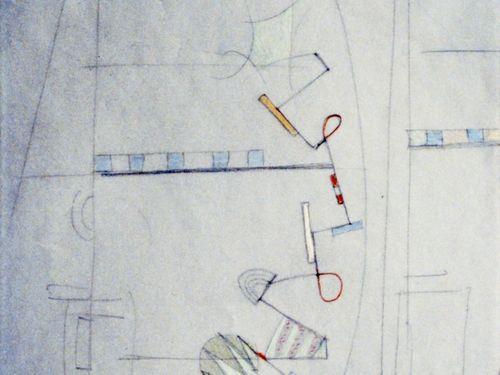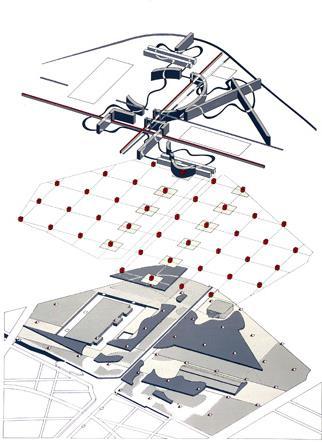
2 minute read
Systems
Tschumi : Superimposition + Deconstruction

Advertisement
In order to remove any ascendency of a privileged system and organizational elements, the three systems of Points, lines and surfaces are superimposed, negating the possibility of a ‘composition’. The principle of ‘Heterogeneity’ comes into play through the use of diverse, multiple, segregated and inherently confrontational elements. This aims at promoting instability and programmatic madness in the form of a ‘Folie’. 7The three systems work in the form of layers, that can insinuate layers of unexpected change and occasional constructions. The juxtaposition of the different sequences of spaces created by the insertion of the Folies over the surfaces and textures disrupt the coherence and reassuring stability of composition. While fulfilling its goal to prove that was able to construct a complex architectural organization without utilizing the traditional compositional, hierarchical techniques and order, it also strived to displace the existing opposition between architecture and program, questioning the other architectural conventions through ideas of superimpositions, combination, permutation and substitution. In an attack against the notions of cause-and –effect relationships between function, structure, economics or form and program, the strategy substituted these concepts by the idea of contiguity 5
The proposal investigates the thought of structure, which was expressed in the form of a point grid, the coordinate axes (covered galleries) and the random curve (cinematic promenade). By employing the methods of superimposition, the autonomous and completely logical structures questioned the idea of it being an orderly, coherent machine. It established the fact that it could never work as a supercoherent megastructure but would be something undecidable, opposing the notion of totality. It encouraged conflict over synthesis, fragmentation over unity, madness and play over careful management. The deconstructive ideology of the park rejected the context, making it anticontextual and subverting the notion of borders on which its context depends.
The initial hypothesis by OMA is based upon the nature of the programme of the Park of La Villette that aims to be a series of social instruments running across the site in a dense manner. The programme is understood as a suggestion and not a list of functions that need to be inhabited in the Park. The design strategy here works towards creating a proposition of a ‘method’ that would respond to the constant changes and adjustments that the Park would undergo by combining architectural specificity with programmatic indeterminacy. This would entail that the proposal is not simply a design but a tactical tool derived to gain the maximum amount of benefit from the multitude of activities implanted on the site.
The use of nature is considered to be of the most efficient and explosive manner which would result in a stable and aesthetic experience to the user. The essence of the proposition becomes a question of how to orchestrate on a metropolitan field the most dynamic coexistence of activities x,y and z to generate through their mutual interference a chain reaction of new unprecedented events.8 The Park would work as a social condenser that would have its roots in the horizontal congestion of the size of the Park The method to achieve this is through using superimposition of projections The revolutionary understanding of how an urban Park works lies in their understanding of the fact that the more the park works, the more it will be in a perpetual state of revision







